2010 Reviews
 Idaho Paddler: Whitewater Gems: A Rafters and Kayakers Guide. By Sean Glaccum. Distributed by Payette River Company, Ketchum, ID. No ISBN.
Idaho Paddler: Whitewater Gems: A Rafters and Kayakers Guide. By Sean Glaccum. Distributed by Payette River Company, Ketchum, ID. No ISBN.
The realm of whitewater possibility continues to expand as attested by this new guide on Idaho rivers. Idaho Paddler is primarily oriented to steep creeks, big rapids and falls, but it also includes short descriptions of selected play waves and one-page summaries of traditional runs like the Middle Fork of the Salmon and the Selway. It's notably sparing on text, but visually pleasing with lots of color photos. You can also purchase a companion DVD.
To purchase a copy of the book or DVD, visit the Payette River Company's website
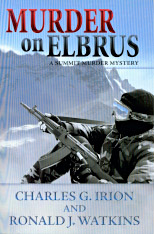 Murder on Elbrus. By Charles G. Irion and Ronald J. Watkins. Iroin Books, Phoenix. ISBN 9780984161829
Murder on Elbrus. By Charles G. Irion and Ronald J. Watkins. Iroin Books, Phoenix. ISBN 9780984161829
This is the third in a series of mountain murder mysteries. (Abandoned on Everest and Murder on Everest are the two previous books and are reviewed below.) Prudent authors learn from their mistakes, and Irion and Watkins are prudent. They haven't repeated the same mistake as their first book and this is a substantial improvement. Murder on Elbrus, their newest installment, is an engaging diversion for a rainy day. Mount Elbrus is in Russia, located in the western Caucasus range, and at 18,510 feet is the highest peak is Europe. Mountaineer Scott Devlon reappears from the previous book and is suddenly in trouble when Russia's Deputy Prime Minister is murdered on Elbrus. It's all there, played out against the backdrop of the Caucasus: the beautiful Natasha, the head-strong Tarja, CIA agent Fowel with rumpled suit and creaky knees, the dapper mobster Pyotr with a penchant for fast cars, and the Russian army in hot pursuit.
Amazon.com: More Information or Purchase
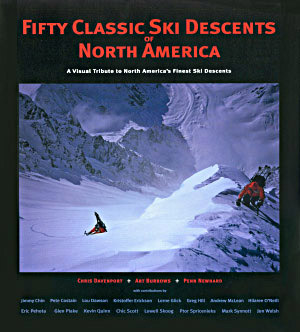 Fifty Classic Ski Descents of North America: A Visual Tribute to North America's Finest Ski Descents. By Chris Davenport, Art Burrows and Penn Newhard. Capitol Peak Publishing, np. ISBN 9780982615430
Fifty Classic Ski Descents of North America: A Visual Tribute to North America's Finest Ski Descents. By Chris Davenport, Art Burrows and Penn Newhard. Capitol Peak Publishing, np. ISBN 9780982615430
This book was one of our "Book of the Year" choices. You'll find a complete review under Best Books of 2010
Amazon.com: More Information or Purchase
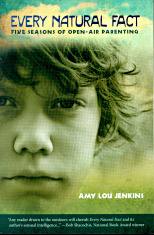 Every Natural Act: Five Seasons of Open Air Parenting. By Amy Lou Jenkins. Holy Cow Press, Duluth, MN. ISBN 9780982354513
Every Natural Act: Five Seasons of Open Air Parenting. By Amy Lou Jenkins. Holy Cow Press, Duluth, MN. ISBN 9780982354513
This book was one of our "Book of the Year" choices. You'll find a complete review under Best Books of 2010
Amazon.com: More Information or Purchase

The Ascent: A Novel of Survival. By Ronald Malfi. Medallion Press, St. Charles, IL. ISBN 9781605420677
Miserable after the death of his wife, the protagonist of the story heads off on a climbing expedition to the Himalaya, and everything goes wrong. One problem is the equipment: flannel sleeping bags, canvas packs, pick-axes (yes, pick-axes instead of ice axes), and an obvious dearth of mountaineering knowledge. One experienced mountaineer on the trip brags about an Alaskan expedition he organized in which they climbed to 26,000 feet. (Which would be quite a feat since the highest summit in Alaska is a 20,320.) But back to our protagonist. Can he and his team climb and claw (mostly claw) their way into the Canyon of Souls where no man has been before? And if they make it, will they escape from the hell that is waiting for them? Unlikely. Highly unlikely, considering that the climbers — and the author who divined them — know nothing about mountaineering.
Amazon.com: More Information or Purchase
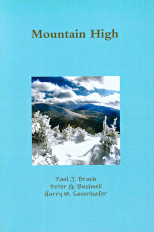 Mountain High. By Paul J Brach, Peter G. Bushnell, and Harry M. Sauerhafer. Lulu.com, np. ISBN 9780557508792
Mountain High. By Paul J Brach, Peter G. Bushnell, and Harry M. Sauerhafer. Lulu.com, np. ISBN 9780557508792
This is largely a series of trail and climbing reports told in a third person manner. The reports mostly center in the Adirondack Mountains, but included also are side journeys to Newfoundland, Mt. Rainier and Nepal.
Amazon.com: More Information or Purchase
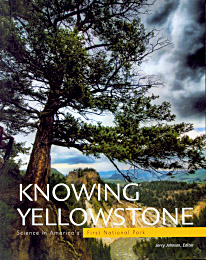 Knowing Yellowstone: Science in America's First National Park. Jerry Johnson, ed. Taylor Trade Publishing. Lanham, Maryland. ISBN 9781589795228
Knowing Yellowstone: Science in America's First National Park. Jerry Johnson, ed. Taylor Trade Publishing. Lanham, Maryland. ISBN 9781589795228
This book was one of our "Book of the Year" choices. You'll find a complete review under Best Books of 2010
Amazon.com: More Information or Purchase
 Abandoned on Everest: A Summit Murder Mystery. By Charles G. Irion and Ronald J. Watkins. Irion Books, Phoenix, AZ ISBN 9780984161812
Abandoned on Everest: A Summit Murder Mystery. By Charles G. Irion and Ronald J. Watkins. Irion Books, Phoenix, AZ ISBN 9780984161812
This is the open salvo of a series of mystery books about murder on the highest mountains in the world. The first two books are about the murder of the fictional character Derek Sodoc on Mt. Everest. In this first volume, Abandoned on Everest, we are told in the preface that the story is authored by tabloid journalist Quentin Stein. Stein is a fictional character. Yet, for someone perusing the shelves of a book store, it appears they are buying a book about a true story about true people and true events. The book's cover shouts disingenuously "True Story of Derek Sodoc's Death." And while I can forgive the authors (and publisher) for playing a harmless trick to entice people to buy the book, I can't forgive them for the inanely written story within its pages. The short of it is: don't bother.
Amazon.com: More Information or Purchase
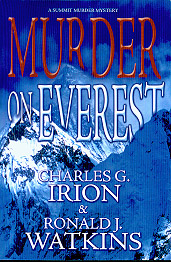 Murder on Everest. By Charles G. Irion and Ronald J. Watkins. Irion Books, Phoenix, AZ ISBN 9780984161805
Murder on Everest. By Charles G. Irion and Ronald J. Watkins. Irion Books, Phoenix, AZ ISBN 9780984161805
This is the second installment in the mountain murder series which began with the above clinker. Better news on this one. Clearly the authors have improved, and while this is not top tier stuff, it's not too bad. In this story, the wealthy Michael Sodoc finances an expedition to recover the body of his son Derek who died high on Everest. Did Derek die from exhaustion and exposure, or was it . . . murder?
Amazon.com: More Information or Purchase
2009 Reviews
 The Coolest Race on Earth: Mud, Madmen, Glaciers and Grannies at the Antarctica Marathon. By John Hanc, Chicago Review Press, ISBN 9781556527388
The Coolest Race on Earth: Mud, Madmen, Glaciers and Grannies at the Antarctica Marathon. By John Hanc, Chicago Review Press, ISBN 9781556527388
If you're a runner, you're going to love this book! Put away any of those ideas that a book on running is dry. Not this one. Not in author John Hanc's hands. Hanc knows the craft of writing, and he knows how to keep a book moving along at a good clip. You'll quickly find yourself keeping pace, running with him in one of the craziest, most adventurous marathons ever.
![]() You'll find a more complete review under Best Books of 2009
You'll find a more complete review under Best Books of 2009
Amazon.com: More Information or Purchase

Wild Moments: Adventures with Animals of the North. Edited by Michael Engelhard. University of Alaska Press. ISBN 9781602230484
Wild Moments is an anthology of writings by 33 contemporary writers and naturalists. Each writer describes their encounter with a particular species such as snow geese, wolverines, musk oxen, mountain goats, and more. It's quite a nice approach to a nature book, and you'll find much to enjoy in your own encounter with Wild Moments.
Amazon.com: More Information or Purchase
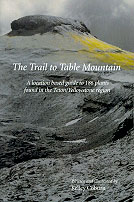
The Trail to Table Mountain: A Location Based Guide to 186 Plants Found in the Teton-Yellowstone Region. Written and Illustrated by Kelley Coburn. Black Timber Press. ISBN 9780615218946
This is a guide to the plants found along the trail leading to the top of Table Mountain. The mountain lies on the west slope, or the Idaho side, of the Tetons near the town of Driggs. Before I sat down with the book, I thought I might read a chapter here and there, skipping throughout until I got a feel for it. But from the first few pages, I was completely taken in by Coburn's soothing voice, his well chosen words, and the way in which the book is ordered and arranged. I found myself totally absorbed. All in all, this is a superb guidebook
Amazon.com: More Information or Purchase
OR Available from: Dark Horse Books in Driggs, Idaho (phone: (208) 354-8882 / email: dhbooks@tetonvalley.net)
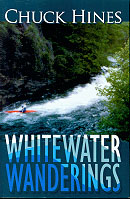
Whitewater Wanderings by Chuck Hines, AuthorHouse ISBN 9781434385369
In the later decades of the 1900s, Chuck Hines was very much the kayaking world's impresario. It came from his work with the YMCA, a career that spanned 40 years. Early in his professional life, he developed aquatic programs for "the Y," and in later years, he created and managed the YMCA's national kayaking program. His influence was felt far beyond the YMCA, and he was very active in the competitive kayaking scene: coaching athletes and volunteering for the Atlanta Olympics. In his book, Hines reflects back on a full life of wanderings and adventures.
Amazon.com: More Information or Purchase

South Crop Forest. By Lorne Rothman, iUniverse. ISBN 9780595495887
This self published fictional work for pre-teen, teens and adults is an interesting combination of fantasy and natural history. The story revolves around a legendary creature who embarks on a quest to save the forest's greatest treasure from destruction.
Amazon.com: More Information or Purchase

Alaska/Yukon/Arctic Light: Gifts of the Wild. By Kathleen M. K. Menke. Crystal Images, Haines, AK. ISBN 9780976426110
This is a beautiful, new photographic book on Alaska's wildlife. Menke has a sharp eye for just the right combination of light and shadow. The book is graced by photographs taken along the Yukon River, Denali and Kluane National Parks, and Tetlin and the Arctic National Wildlife refuges.
Amazon.com: More Information or Purchase
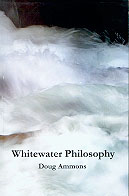 Whitewater Philosophy. By Doug Ammons. Water Nymph Press, Missoula, MT. ISBN 9780976158011
Whitewater Philosophy. By Doug Ammons. Water Nymph Press, Missoula, MT. ISBN 9780976158011
Doug Ammons always has something up his writer's sleeve, always something thoughtful to say about his kayaking experiences. In this book he zeros in on philosophy. Philosophy? Here's how Ammons describes it: "I chose the word philosophy because every essay here is about our values and beliefs and expresses the ways in which the river becomes an intimate and important part of our lives. It is a set of themes about adventure sports, because all of them in their own way confront us with the critical problem of how a weak, awkward human is able to fit into the natural world, and live with its sharp edges and awe-inspiring powers."
Available from the author: https://www.dougammons.com/
2008 Reviews

The Accidental Explorer: Wayfinding in Alaska By Sherry Simpson. Sawquatch Books, Seattle, WA ISBN 9781570615375
An literate and insightful collection of outdoor writings by an outstanding Alaskan author.
This one gets our nod for the one the best books of the year. You'll find a more complete review under Best Books of 2008
Amazon.com: More Information or Purchase

The Milepost: Alaska Travel Planner Kris Valencia (ed). Morris Communications Company, Augusta GA ISBN 9781892154248
Can it be? Yes, it's the 60th edition of this well-known, mile-by-mile travel guide to the Alaska's highways and roads.
Amazon.com: More Information or Purchase
 Search for a Perfect State of Colorado By William Hood. Bauu Press, Boulder, CO ISBN 9780972134972
Search for a Perfect State of Colorado By William Hood. Bauu Press, Boulder, CO ISBN 9780972134972
A self-published volume of a little of everything: hitch-hiking and backpacking, marriage and family, history and politics, rain and religion, job loss and job gain.
Amazon.com: More Information or Purchase
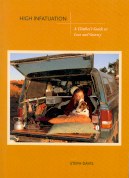 High Infatuation: A Climber's Guide to Love and Gravity. By Steph Davis. The Mountaineers Books, Seattle ISBN 9781594850653
High Infatuation: A Climber's Guide to Love and Gravity. By Steph Davis. The Mountaineers Books, Seattle ISBN 9781594850653
Steph Davis is one of the finest female climbers in the world -- and she's also on her way to becoming one of climbing's finest writers.
Things could have been a lot different for Davis. She could have been a concert pianist, but life is funny that way. You try something new, ambling tentatively in one direction, and suddenly you veer off another way and find yourself whisked off to the lonely, vertical heights of Patagonia, Baffin, Kyrgyzstan, Pakistan and, not-so-lonely, Yosemite.
In a series of short narratives, Davis not only tells of these climbing adventures but also of the challenge of balancing relationships with a vagabond life on the road.
By far her best piece comes early in the book about a trip to Fremont Canyon in Wyoming. It certainly numbers among some of the best climbing writing ever: a chilling and haunting piece that places her creative talents on full display. And while the rest of the book doesn't quite rise to the high standards she sets early on, it's still quite good, far more creative than most. All in all, it's a fine first effort and we look forward to more from Davis: climbing and writing.
Amazon.com: More Information or Purchase
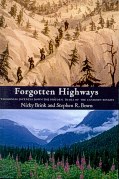 Forgotten Highways: Wilderness Journeys Down the Historic Trails o fhte Canadian Rockies. By Nicky Brink and Stephen R. Brown. Brindle & Glass Publishing. ISBN 9781897142240
Forgotten Highways: Wilderness Journeys Down the Historic Trails o fhte Canadian Rockies. By Nicky Brink and Stephen R. Brown. Brindle & Glass Publishing. ISBN 9781897142240
Nicky Brink and Stephen Brown have a great idea: to travel the historic trails of the Canadian Rockies on foot or ski, and then write about it -- which they do quite well. They follow the trails of David Thompson, Sir George Simpson, Captain John Palliser and Mary Schaffer, and very effectively weave their stories of personal exploration along with those of historic exploration. The book is nicely written and well balanced: interesting and educational, a fine way to familiarize oneself with Canadian pioneering history and wildland geography.
Amazon.com: More Information or Purchase
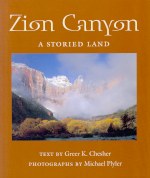 Zion Canyon: A Storied Land. By Greer K. Chesher. Photographs by Michael Plyler. The University of Arizona Press, Tucson. ISBN 0816524874
Zion Canyon: A Storied Land. By Greer K. Chesher. Photographs by Michael Plyler. The University of Arizona Press, Tucson. ISBN 0816524874
This short volume leaves us wanting more from the Greer Chesher's pen, but it's a good sampler with some fine and artistic black and photography to boot. The book, only 80 pages long, is primarily intended to give readers a feel for this unique national park.
It's the sort of pictorial book you often find at National Park visitor centers, but this one easily rises above the typical fare. Chesher and photographer Michael Plyler are from southern Utah. They haven't been sent out to Zion on a two week research trip by a New York publisher. Thank goodness. Rather, it's their backyard, and, thus, the book is not artificially contrived and speaks to the reader with a comfortable intimacy.
One of the highlights of the book is Chesher's story of a canyoneering trip through the Right Fork of North Creek, a journey which culminates with a scary night following a surprise flash flood. If you are planning to visit Zion, this is the perfect introduction.
Amazon.com: More Information or Purchase
2008
 High Infatuation: A Climber's Guide to Love and Gravity. By Steph Davis. The Mountaineers Books, Seattle ISBN 9781594850653
High Infatuation: A Climber's Guide to Love and Gravity. By Steph Davis. The Mountaineers Books, Seattle ISBN 9781594850653
Steph Davis is one of the finest female climbers in the world -- and she's also on her way to becoming one of climbing's finest writers.
Things could have been a lot different for Davis. She could have been a concert pianist, but life is funny that way. You try something new, ambling tentatively in one direction, and suddenly you veer off another way and find yourself whisked off to the lonely, vertical heights of Patagonia, Baffin, Kyrgyzstan, Pakistan and, not-so-lonely, Yosemite.
In a series of short narratives, Davis not only tells of these climbing adventures but also of the challenge of balancing relationships with a vagabond life on the road.
By far her best piece comes early in the book about a trip to Fremont Canyon in Wyoming. It certainly numbers among some of the best climbing writing ever: a chilling and haunting piece that places her creative talents on full display. And while the rest of the book doesn't quite rise to the high standards she sets early on, it's still quite good, far more creative than most. All in all, it's a fine first effort and we look forward to more from Davis: climbing and writing.
Amazon.com: More Information or Purchase
 Forgotten Highways: Wilderness Journeys Down the Historic Trails o fhte Canadian Rockies. By Nicky Brink and Stephen R. Brown. Brindle & Glass Publishing. ISBN 9781897142240
Forgotten Highways: Wilderness Journeys Down the Historic Trails o fhte Canadian Rockies. By Nicky Brink and Stephen R. Brown. Brindle & Glass Publishing. ISBN 9781897142240
Nicky Brink and Stephen Brown have a great idea: to travel the historic trails of the Canadian Rockies on foot or ski, and then write about it -- which they do quite well. They follow the trails of David Thompson, Sir George Simpson, Captain John Palliser and Mary Schaffer, and very effectively weave their stories of personal exploration along with those of historic exploration. The book is nicely written and well balanced: interesting and educational, a fine way to familiarize oneself with Canadian pioneering history and wildland geography.
Amazon.com: More Information or Purchase
 Zion Canyon: A Storied Land. By Greer K. Chesher. Photographs by Michael Plyler. The University of Arizona Press, Tucson. ISBN 0816524874
Zion Canyon: A Storied Land. By Greer K. Chesher. Photographs by Michael Plyler. The University of Arizona Press, Tucson. ISBN 0816524874
This short volume leaves us wanting more from the Greer Chesher's pen, but it's a good sampler with some fine and artistic black and photography to boot. The book, only 80 pages long, is primarily intended to give readers a feel for this unique national park.
It's the sort of pictorial book you often find at National Park visitor centers, but this one easily rises above the typical fare. Chesher and photographer Michael Plyler are from southern Utah. They haven't been sent out to Zion on a two week research trip by a New York publisher. Thank goodness. Rather, it's their backyard, and, thus, the book is not artificially contrived and speaks to the reader with a comfortable intimacy.
One of the highlights of the book is Chesher's story of a canyoneering trip through the Right Fork of North Creek, a journey which culminates with a scary night following a surprise flash flood. If you are planning to visit Zion, this is the perfect introduction.
Amazon.com: More Information or Purchase
2008
 High Infatuation: A Climber's Guide to Love and Gravity. By Steph Davis. The Mountaineers Books, Seattle ISBN 9781594850653
High Infatuation: A Climber's Guide to Love and Gravity. By Steph Davis. The Mountaineers Books, Seattle ISBN 9781594850653
Steph Davis is one of the finest female climbers in the world -- and she's also on her way to becoming one of climbing's finest writers.
Things could have been a lot different for Davis. She could have been a concert pianist, but life is funny that way. You try something new, ambling tentatively in one direction, and suddenly you veer off another way and find yourself whisked off to the lonely, vertical heights of Patagonia, Baffin, Kyrgyzstan, Pakistan and, not-so-lonely, Yosemite.
In a series of short narratives, Davis not only tells of these climbing adventures but also of the challenge of balancing relationships with a vagabond life on the road.
By far her best piece comes early in the book about a trip to Fremont Canyon in Wyoming. It certainly numbers among some of the best climbing writing ever: a chilling and haunting piece that places her creative talents on full display. And while the rest of the book doesn't quite rise to the high standards she sets early on, it's still quite good, far more creative than most. All in all, it's a fine first effort and we look forward to more from Davis: climbing and writing.
Amazon.com: More Information or Purchase
 Forgotten Highways: Wilderness Journeys Down the Historic Trails o fhte Canadian Rockies. By Nicky Brink and Stephen R. Brown. Brindle & Glass Publishing. ISBN 9781897142240
Forgotten Highways: Wilderness Journeys Down the Historic Trails o fhte Canadian Rockies. By Nicky Brink and Stephen R. Brown. Brindle & Glass Publishing. ISBN 9781897142240
Nicky Brink and Stephen Brown have a great idea: to travel the historic trails of the Canadian Rockies on foot or ski, and then write about it -- which they do quite well. They follow the trails of David Thompson, Sir George Simpson, Captain John Palliser and Mary Schaffer, and very effectively weave their stories of personal exploration along with those of historic exploration. The book is nicely written and well balanced: interesting and educational, a fine way to familiarize oneself with Canadian pioneering history and wildland geography.
Amazon.com: More Information or Purchase
 Zion Canyon: A Storied Land. By Greer K. Chesher. Photographs by Michael Plyler. The University of Arizona Press, Tucson. ISBN 0816524874
Zion Canyon: A Storied Land. By Greer K. Chesher. Photographs by Michael Plyler. The University of Arizona Press, Tucson. ISBN 0816524874
This short volume leaves us wanting more from the Greer Chesher's pen, but it's a good sampler with some fine and artistic black and photography to boot. The book, only 80 pages long, is primarily intended to give readers a feel for this unique national park.
It's the sort of pictorial book you often find at National Park visitor centers, but this one easily rises above the typical fare. Chesher and photographer Michael Plyler are from southern Utah. They haven't been sent out to Zion on a two week research trip by a New York publisher. Thank goodness. Rather, it's their backyard, and, thus, the book is not artificially contrived and speaks to the reader with a comfortable intimacy.
One of the highlights of the book is Chesher's story of a canyoneering trip through the Right Fork of North Creek, a journey which culminates with a scary night following a surprise flash flood. If you are planning to visit Zion, this is the perfect introduction.
Amazon.com: More Information or Purchase
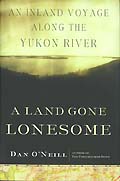 A Land Gone Lonesome: An Inland Voyage along the Yukon River. By Dan O'Neill. Counterpoint, New York ISBN 1582433445
A Land Gone Lonesome: An Inland Voyage along the Yukon River. By Dan O'Neill. Counterpoint, New York ISBN 1582433445
This is one of the finest books of the year, a high caliber work, outstanding in every way. Alaskan Dan O'Neill takes his canoe down the Yukon from Dawson, of Klondike gold rush fame, to Circle City where according O'Neil "the channels of the Yukon spraddle like a fat women's legs released from their stockings." It's a lengthy and reflective journey from present to past and back to present. Along the way, O'Neill stops to chat with the river's few scattered residents, many of whom he knows. He visits cabins, kicks around in old prospects, and looks in the brush for the remains of old homesteads.
As he moves down river, an engrossing story emerges of men and women attempting to eek out a living in the Alaskan wilderness. Some make it. Some don't, such as a young man known only as Smeagol. He froze to death one winter in a small, windowless cabin ten miles up the Kandik, a tributary of the Yukon. He was found in the spring, but since the ground was still frozen, he couldn't be buried and his body was laid outside the cabin. When Smeagol was checked upon later that summer, he was gone, courtesy of a resident pack of wolves. Nothing remained of him: not a bone, not a scrap.
If you think about it, it's a nice way of going -- when you're ready for it, of course. There's no mess to clean up. You don't take up space in a city cemetery. You help fed some hungry members of the local community, which is far better than being stored away in a box where you do no good. And it doesn't cost a thing.
Years ago, I had spent a little time in this country, quite happily managing to escape Smeagol's fate. I had kayaked a portion of the Yukon downsteam from Dawson and had run the Forty Mile, the South and main Tatonduk Rivers, which are mentioned in O'Neil's account. I wish that O'Neil's book had been available back then. My journey would have been far richer.
Much of the area through which O'Neil travels is the Yukon-Charley Rivers National Preserve, a part of the National Park System. The Preserve's enabling legislation made allowance for the subsistence lifestyle to continue within its boundaries. It created, essentially, the last place in the U.S. where a limited number of homesteaders could live on and with the land. But what O'Neill reveals in A Land Gone Lonesome is that just the opposite has occurred. Park Service bureaucracy has gradually push homesteaders off the land and prevented new comers from taking their place.
O'Neil's book is an eloquent plea to preserve both the Alaskan wilderness and its back-to-the-land lifestyle. The book is uncommonly well written, imbued with understated humor and passion. It's a story that needs to be told, and O'Neil was the right person to do it.
Amazon.com: More Information or Purchase
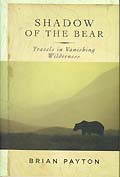 Shadow of the Bear: Travels in Vanishing Wilderness. By Brian Payton. Penguin Group (Canada), Toronto. ISBN 1596911980
Shadow of the Bear: Travels in Vanishing Wilderness. By Brian Payton. Penguin Group (Canada), Toronto. ISBN 1596911980
"My journey began with a dream," Brian Payton tells us early in Shadow of the Bear. In his dream, he comes across a bear sitting on a log, wearing tattered overalls, trying to read from a book. Quite naturally Payton sits down with the bear and begins to teach it how to read.
The dream effectively frames and gives purpose to his book. Payton takes us on not one but several journeys, introducing us to individuals he meets along the way, and using artfully crafted stories, he teaches us, his readers, about the bears of the world.
Payton explains up front that he had much to learn -- starting with the basics, like how many species of bear are found in the world. He knew something about grizzly, black and polar bears which are familiar to North Americans. China's beloved giant panda bear, of course, was on his mental list, as well as Russia's brown bear, but, he learned that there are more.
In fact, eight species of bears inhabit the world, and the nosy and prying Payton sets out on a succession of trips to find and learn about each one. His trips take him to India, Peru, Cambodia, Italy, France, Manitoba and the Colorado Plateau.
This is not a scientific book written in stiff prose and filled with facts and figures. The basic scientific information is there, of course, but the book is best described as a non-fictional novel. There is movement from beginning to end, interesting supporting characters, just the right amount of dialog, and even something of a resolution upon the book's completion.
Payton is an unusually good story teller. He has a light touch, and except on occasion, most particularly when it comes to hunting bears, he doesn't interject himself too forcefully in the narrative. You'll find him quietly sitting down with you on that log in the forest, and in a short while, you'll be caught up and learning about the world's bears in the most engaging way.
Amazon.com: More Information or Purchase
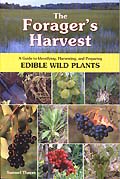 The Forager's Harvest: A Guide to Identifying, Harvesting and Preparing Edible Wild Plants. By Samuel Thayer. Forager Harvest, Ogema, WI. ISBN 0976626608
The Forager's Harvest: A Guide to Identifying, Harvesting and Preparing Edible Wild Plants. By Samuel Thayer. Forager Harvest, Ogema, WI. ISBN 0976626608
There are a lot of bad books out there on edible plants. Most of their deficiencies can be traced to one very fundamental problem: the author hasn't eaten the plant he claims to be edible.
To find reliable work in edible plants, one nearly has to go back to Euell Gibbon's books (Stalking the Wild Asparagus and others) which came out in the sixties and seventies. Gibbons painstakingly tried all of the wild foods that he included in his books, and consequently, his work is dependable. Not so with many books since. Trying to capitalize on Gibbons' popularity and writing success, various publishers, big and small, put out a secession of edible plant books, almost all of them marred with inaccuracies. While there have been a couple of reliable books published since, the literature on a whole is altogether on the discouraging side.
That's why Samuel Thayer's new book The Forager Harvest is so welcomed. What sets it apart is Thayer's clear experience in the field. He has eaten every plant in his book, not once or twice, but at least 50 times. The plants aren't glossed over. Each is described in detail. The color photos which supplement the descriptive material are clear and instructive. In addition to identification characteristics, he describes when the plant is ready for human consumption, and how to harvest and prepare it.
Everything about the book has the stamp of authority. Thayer knows his subject and he knows it well. The book is a self-published volume which can immediately raise a red flag. Such books often lack the discipline of a strong and objective editor who cuts through extraneous material and keeps the author's fancies in check. Too, self published books often lag in the lay-out and design departments.
But none of those faults are present in The Forager's Harvest. On the contrary, it is very attractively designed. The writing is excellent and well edited. In fact, by going the self publishing route, Thayer's end product is far better than if he had turned it over to big-city publishers who are often bent on economy over substance. There is plenty of substance here, and no fluff. All thumbs up. The Forager's Harvest is a first-rate guidebook.
Amazon.com: More Information or Purchase
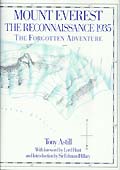 Mount Everest: The Reconnaissance 1935, The Forgotten Adventure. By Tony Astill. Les Alpes Livres, Southampton. ISBN 0954920104
Mount Everest: The Reconnaissance 1935, The Forgotten Adventure. By Tony Astill. Les Alpes Livres, Southampton. ISBN 0954920104
This book gets the nod for the best comprehensive outdoor historical work published this year.
Using journals and letters, Tony Astill reconstructs the 1935 British expedition to the Everest and nearby environs. The expedition was led by the indomitable Eric Shipton, one of the great mountain explorers of the Twentieth Century. This was Shipton's second trip to Everest. He would return to the mountain three more times. In his final attempt in 1951, he discovered the route which, two years later, would be utilized for the successful first ascent of the mountain by Sir Edmund Hillary and Tenzing Norgay.
Interestingly enough, it was Shipton who during the 1935 expedition gave Everest summiter Norgay his first climbing job. In addition, to launching Norgay's career, the 1935 Expedition was critically important to mountaineers' understanding of the Everest region. No one really knew, for example, when were the best times to climb in the Himalaya. In 1935, Shipton was climbing during the monsoon, and his experiences put to rest any ideas that the monsoon held any advantage. He quickly deduced that the problems created by deep and unstable snow could be minimized by climbing during pre winter or pre-monsoon seasons.
While the expedition was not successful in climbing as high as previous attempts on Everest, it did climb many nearby peaks. In fact, it was one of the most profligate climbing expeditions to the Himalaya ever. Twenty-four first ascents were made of peaks over 20,000 feet in elevation.
With all its importance, you would expect that much has been written about the 1935 expedition. Actually, very little has, and no books have ever been published. With Astill's book that deficiency has been corrected. Mount Everest: The Reconnaissance 1935 is not a fast-paced, edge-of-the-seat read. Rather, the book is more scholarly in composition, carrying on a running narrative with frequent uses of long quotes from diaries or letters of the expedition members.
Astill's book is a gallant effort, clearly a labor of love and an important addition to mountaineering literature.
Available Directly from the Author. Contact him at astill.tony@googlemail.com / Website: www.les-alpes-livres.com
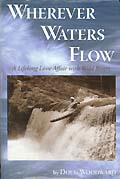 Wherever Waters Flow: A Lifelong Love Affair with Wild Rivers By Doug Woodward. Headwaters Publishing, Franklin, NC ISBN 0977931404
Wherever Waters Flow: A Lifelong Love Affair with Wild Rivers By Doug Woodward. Headwaters Publishing, Franklin, NC ISBN 0977931404
This year's pick for a whitewater book is Doug Woodward's Wherever the Waters Flow. For many years, Woodward has been an important influence in southeastern boating. He introduced former president Jimmy Carter to kayaking. He helped with the stunt work for the film Deliverance. There's a relaxing, down home feel to this book -- and plenty of warmth.
Woodward spent a good portion of his life turning kids onto kayaking and he has some great stories to tell. One is a rollicking Colorado River adventure with a group of scouts and an old broken-down school bus. Included also among his reminiscences are adventures with his own children, and you'll love their names: Cricket, David, Autumn, Forest, Rivers and Canyon. Summed up: it's a big-hearted, doggone good book.
Available Directly from the Author's Website: Wherever Waters Flow
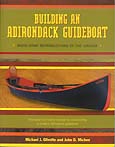 Building an Adirondack Guideboat By Michael J. Olivette and John Michne. Nicholas K. Burns Publishing, Utica, NY ISBN 0971306990.
Building an Adirondack Guideboat By Michael J. Olivette and John Michne. Nicholas K. Burns Publishing, Utica, NY ISBN 0971306990.
The Adirondack guideboat is the BMW of row boats. When you see one of these elegant boats gliding effortlessly across the water, you'll get a lump in your throat. Made of wood, they have sensuous lines, curving gracefully from the midsection to an upturned and pointed bow and stern. It looks very much like a canoe but it's propelled by oars. If you want the coolest looking boat on the lake, and you enjoy woodworking, this is the book for you: a step-by-step guide on how to build these beautiful boats.
Amazon.com: More Information or Purchase
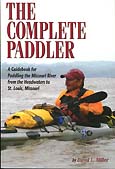 The Complete Paddler: A Guidebook for Paddling the Missouri River from the Headwaters to St. Louis, Missouri By David Miller. Farcountry Press, Helena, MT. ISBN 1560373253.
The Complete Paddler: A Guidebook for Paddling the Missouri River from the Headwaters to St. Louis, Missouri By David Miller. Farcountry Press, Helena, MT. ISBN 1560373253.
If you're retracing the Lewis & Clark trail -- or if you have a hankering to paddle the Missouri -- you'll want a copy of David Miller's Complete Paddler. Miller teaches map making, and you can rely on his maps and GPS coordinates to keep you oriented. All the important pieces are there: mileages, camps, portage routes, and helpful tidbits. It's the Missouri River's paddling bible.
Amazon.com: More Information or Purchase
2005
 A Land Gone Lonesome: An Inland Voyage along the Yukon River. By Dan O'Neill. Counterpoint, New York ISBN 1582433445
A Land Gone Lonesome: An Inland Voyage along the Yukon River. By Dan O'Neill. Counterpoint, New York ISBN 1582433445
This is one of the finest books of the year, a high caliber work, outstanding in every way. Alaskan Dan O'Neill takes his canoe down the Yukon from Dawson, of Klondike gold rush fame, to Circle City where according O'Neil "the channels of the Yukon spraddle like a fat women's legs released from their stockings." It's a lengthy and reflective journey from present to past and back to present. Along the way, O'Neill stops to chat with the river's few scattered residents, many of whom he knows. He visits cabins, kicks around in old prospects, and looks in the brush for the remains of old homesteads.
As he moves down river, an engrossing story emerges of men and women attempting to eek out a living in the Alaskan wilderness. Some make it. Some don't, such as a young man known only as Smeagol. He froze to death one winter in a small, windowless cabin ten miles up the Kandik, a tributary of the Yukon. He was found in the spring, but since the ground was still frozen, he couldn't be buried and his body was laid outside the cabin. When Smeagol was checked upon later that summer, he was gone, courtesy of a resident pack of wolves. Nothing remained of him: not a bone, not a scrap.
If you think about it, it's a nice way of going -- when you're ready for it, of course. There's no mess to clean up. You don't take up space in a city cemetery. You help fed some hungry members of the local community, which is far better than being stored away in a box where you do no good. And it doesn't cost a thing.
Years ago, I had spent a little time in this country, quite happily managing to escape Smeagol's fate. I had kayaked a portion of the Yukon downsteam from Dawson and had run the Forty Mile, the South and main Tatonduk Rivers, which are mentioned in O'Neil's account. I wish that O'Neil's book had been available back then. My journey would have been far richer.
Much of the area through which O'Neil travels is the Yukon-Charley Rivers National Preserve, a part of the National Park System. The Preserve's enabling legislation made allowance for the subsistence lifestyle to continue within its boundaries. It created, essentially, the last place in the U.S. where a limited number of homesteaders could live on and with the land. But what O'Neill reveals in A Land Gone Lonesome is that just the opposite has occurred. Park Service bureaucracy has gradually push homesteaders off the land and prevented new comers from taking their place.
O'Neil's book is an eloquent plea to preserve both the Alaskan wilderness and its back-to-the-land lifestyle. The book is uncommonly well written, imbued with understated humor and passion. It's a story that needs to be told, and O'Neil was the right person to do it.
Amazon.com: More Information or Purchase
 Shadow of the Bear: Travels in Vanishing Wilderness. By Brian Payton. Penguin Group (Canada), Toronto. ISBN 1596911980
Shadow of the Bear: Travels in Vanishing Wilderness. By Brian Payton. Penguin Group (Canada), Toronto. ISBN 1596911980
"My journey began with a dream," Brian Payton tells us early in Shadow of the Bear. In his dream, he comes across a bear sitting on a log, wearing tattered overalls, trying to read from a book. Quite naturally Payton sits down with the bear and begins to teach it how to read.
The dream effectively frames and gives purpose to his book. Payton takes us on not one but several journeys, introducing us to individuals he meets along the way, and using artfully crafted stories, he teaches us, his readers, about the bears of the world.
Payton explains up front that he had much to learn -- starting with the basics, like how many species of bear are found in the world. He knew something about grizzly, black and polar bears which are familiar to North Americans. China's beloved giant panda bear, of course, was on his mental list, as well as Russia's brown bear, but, he learned that there are more.
In fact, eight species of bears inhabit the world, and the nosy and prying Payton sets out on a succession of trips to find and learn about each one. His trips take him to India, Peru, Cambodia, Italy, France, Manitoba and the Colorado Plateau.
This is not a scientific book written in stiff prose and filled with facts and figures. The basic scientific information is there, of course, but the book is best described as a non-fictional novel. There is movement from beginning to end, interesting supporting characters, just the right amount of dialog, and even something of a resolution upon the book's completion.
Payton is an unusually good story teller. He has a light touch, and except on occasion, most particularly when it comes to hunting bears, he doesn't interject himself too forcefully in the narrative. You'll find him quietly sitting down with you on that log in the forest, and in a short while, you'll be caught up and learning about the world's bears in the most engaging way.
Amazon.com: More Information or Purchase
 The Forager's Harvest: A Guide to Identifying, Harvesting and Preparing Edible Wild Plants. By Samuel Thayer. Forager Harvest, Ogema, WI. ISBN 0976626608
The Forager's Harvest: A Guide to Identifying, Harvesting and Preparing Edible Wild Plants. By Samuel Thayer. Forager Harvest, Ogema, WI. ISBN 0976626608
There are a lot of bad books out there on edible plants. Most of their deficiencies can be traced to one very fundamental problem: the author hasn't eaten the plant he claims to be edible.
To find reliable work in edible plants, one nearly has to go back to Euell Gibbon's books (Stalking the Wild Asparagus and others) which came out in the sixties and seventies. Gibbons painstakingly tried all of the wild foods that he included in his books, and consequently, his work is dependable. Not so with many books since. Trying to capitalize on Gibbons' popularity and writing success, various publishers, big and small, put out a secession of edible plant books, almost all of them marred with inaccuracies. While there have been a couple of reliable books published since, the literature on a whole is altogether on the discouraging side.
That's why Samuel Thayer's new book The Forager Harvest is so welcomed. What sets it apart is Thayer's clear experience in the field. He has eaten every plant in his book, not once or twice, but at least 50 times. The plants aren't glossed over. Each is described in detail. The color photos which supplement the descriptive material are clear and instructive. In addition to identification characteristics, he describes when the plant is ready for human consumption, and how to harvest and prepare it.
Everything about the book has the stamp of authority. Thayer knows his subject and he knows it well. The book is a self-published volume which can immediately raise a red flag. Such books often lack the discipline of a strong and objective editor who cuts through extraneous material and keeps the author's fancies in check. Too, self published books often lag in the lay-out and design departments.
But none of those faults are present in The Forager's Harvest. On the contrary, it is very attractively designed. The writing is excellent and well edited. In fact, by going the self publishing route, Thayer's end product is far better than if he had turned it over to big-city publishers who are often bent on economy over substance. There is plenty of substance here, and no fluff. All thumbs up. The Forager's Harvest is a first-rate guidebook.
Amazon.com: More Information or Purchase
 Mount Everest: The Reconnaissance 1935, The Forgotten Adventure. By Tony Astill. Les Alpes Livres, Southampton. ISBN 0954920104
Mount Everest: The Reconnaissance 1935, The Forgotten Adventure. By Tony Astill. Les Alpes Livres, Southampton. ISBN 0954920104
This book gets the nod for the best comprehensive outdoor historical work published this year.
Using journals and letters, Tony Astill reconstructs the 1935 British expedition to the Everest and nearby environs. The expedition was led by the indomitable Eric Shipton, one of the great mountain explorers of the Twentieth Century. This was Shipton's second trip to Everest. He would return to the mountain three more times. In his final attempt in 1951, he discovered the route which, two years later, would be utilized for the successful first ascent of the mountain by Sir Edmund Hillary and Tenzing Norgay.
Interestingly enough, it was Shipton who during the 1935 expedition gave Everest summiter Norgay his first climbing job. In addition, to launching Norgay's career, the 1935 Expedition was critically important to mountaineers' understanding of the Everest region. No one really knew, for example, when were the best times to climb in the Himalaya. In 1935, Shipton was climbing during the monsoon, and his experiences put to rest any ideas that the monsoon held any advantage. He quickly deduced that the problems created by deep and unstable snow could be minimized by climbing during pre winter or pre-monsoon seasons.
While the expedition was not successful in climbing as high as previous attempts on Everest, it did climb many nearby peaks. In fact, it was one of the most profligate climbing expeditions to the Himalaya ever. Twenty-four first ascents were made of peaks over 20,000 feet in elevation.
With all its importance, you would expect that much has been written about the 1935 expedition. Actually, very little has, and no books have ever been published. With Astill's book that deficiency has been corrected. Mount Everest: The Reconnaissance 1935 is not a fast-paced, edge-of-the-seat read. Rather, the book is more scholarly in composition, carrying on a running narrative with frequent uses of long quotes from diaries or letters of the expedition members.
Astill's book is a gallant effort, clearly a labor of love and an important addition to mountaineering literature.
Available Directly from the Author. Contact him at astill.tony@googlemail.com / Website: www.les-alpes-livres.com
Others that have come across our desk . . .
 Wherever Waters Flow: A Lifelong Love Affair with Wild Rivers By Doug Woodward. Headwaters Publishing, Franklin, NC ISBN 0977931404
Wherever Waters Flow: A Lifelong Love Affair with Wild Rivers By Doug Woodward. Headwaters Publishing, Franklin, NC ISBN 0977931404
This year's pick for a whitewater book is Doug Woodward's Wherever the Waters Flow. For many years, Woodward has been an important influence in southeastern boating. He introduced former president Jimmy Carter to kayaking. He helped with the stunt work for the film Deliverance. There's a relaxing, down home feel to this book -- and plenty of warmth.
Woodward spent a good portion of his life turning kids onto kayaking and he has some great stories to tell. One is a rollicking Colorado River adventure with a group of scouts and an old broken-down school bus. Included also among his reminiscences are adventures with his own children, and you'll love their names: Cricket, David, Autumn, Forest, Rivers and Canyon. Summed up: it's a big-hearted, doggone good book.
Available Directly from the Author's Website: Wherever Waters Flow
 Building an Adirondack Guideboat By Michael J. Olivette and John Michne. Nicholas K. Burns Publishing, Utica, NY ISBN 0971306990.
Building an Adirondack Guideboat By Michael J. Olivette and John Michne. Nicholas K. Burns Publishing, Utica, NY ISBN 0971306990.
The Adirondack guideboat is the BMW of row boats. When you see one of these elegant boats gliding effortlessly across the water, you'll get a lump in your throat. Made of wood, they have sensuous lines, curving gracefully from the midsection to an upturned and pointed bow and stern. It looks very much like a canoe but it's propelled by oars. If you want the coolest looking boat on the lake, and you enjoy woodworking, this is the book for you: a step-by-step guide on how to build these beautiful boats.
Amazon.com: More Information or Purchase
 The Complete Paddler: A Guidebook for Paddling the Missouri River from the Headwaters to St. Louis, Missouri By David Miller. Farcountry Press, Helena, MT. ISBN 1560373253.
The Complete Paddler: A Guidebook for Paddling the Missouri River from the Headwaters to St. Louis, Missouri By David Miller. Farcountry Press, Helena, MT. ISBN 1560373253.
If you're retracing the Lewis & Clark trail -- or if you have a hankering to paddle the Missouri -- you'll want a copy of David Miller's Complete Paddler. Miller teaches map making, and you can rely on his maps and GPS coordinates to keep you oriented. All the important pieces are there: mileages, camps, portage routes, and helpful tidbits. It's the Missouri River's paddling bible.
Amazon.com: More Information or Purchase
The Treehouse Chronicles: One Man's Dream of Life Aloft. By S. Peter Lewis. Illustrations by T.B.R. Walsh. TMC Books, Conway, NH ISBN 0972030743
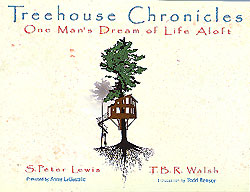 Like the treehouse that Peter Lewis and his friends construct, this is a book permeated with love. There is the love of work. Love of using one's hands. Love of nature. Love of family and friends. Using journal entries, explanatory captions and reflective sidebars, the book covers a three year period in which Lewis envisions and builds a masterpiece of treehouse. For me, the book is somewhat reminiscent of the Whole Earth Catalog with its emphasis on the creative and inspirational power of the individual. At the same time, the book is clearly a creation of the new millennial with stylist lay-out, and carefully rendered water colors, drawings, and color photographs.
Like the treehouse that Peter Lewis and his friends construct, this is a book permeated with love. There is the love of work. Love of using one's hands. Love of nature. Love of family and friends. Using journal entries, explanatory captions and reflective sidebars, the book covers a three year period in which Lewis envisions and builds a masterpiece of treehouse. For me, the book is somewhat reminiscent of the Whole Earth Catalog with its emphasis on the creative and inspirational power of the individual. At the same time, the book is clearly a creation of the new millennial with stylist lay-out, and carefully rendered water colors, drawings, and color photographs.
Amazon.com: More Information or Purchase
Death in the Grizzly Maze: The Timothy Treadwell Story. By Mike Lapinski. Falcon Press, Guilford, CT. ISBN 0762736771
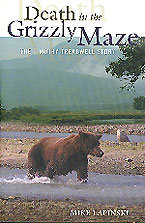 I've always enjoyed Mike Lapinski's work on bears -- and his pluck. As a part of the research for a past book, he had a friend spray him with bear spray. The experience left him stunned and appreciative of how disabling airborne capsicum powder can be. Fortunately, he recovered from the experiment to write Death in the Grizzy Maze.
I've always enjoyed Mike Lapinski's work on bears -- and his pluck. As a part of the research for a past book, he had a friend spray him with bear spray. The experience left him stunned and appreciative of how disabling airborne capsicum powder can be. Fortunately, he recovered from the experiment to write Death in the Grizzy Maze.
In this book, Lapinski chronicles the life of Timothy Treadwell. Treadwell received national attention and became something of media star for living unnaturally close to Alaskan brown bears. Many bear biologists, however, felt he was pushing the limits, and, so it was in the fall of 2003 that he and his girlfriend were mauled and eaten by one or more bears in Katmai National Park.
Lapinski retraces the twisting path followed by Treadwell which led to that tragic day in Katmai. Along the way, we learn about these magnificent animals, their conservation, and the respect that they are clearly due.
Amazon.com: More Information or Purchase
In the Wake of the Jomon: Stone Age Mariners and a Voyage Across the Pacific. By Jon Turk. International Marine / McGraw-Hill, New York. ISBN 0071449027.
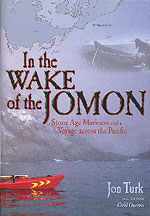 In 1996 anthropologists discovered the 9,500 year old remains of a human that resembled the long-gone Jomon people of northern Japan. The discovery raised fascinating new questions about the origin of Native Americans. One of the key questions was: could have the Jomon people crossed the icy and unforgiving waters of the North Pacific and reached North America?
In 1996 anthropologists discovered the 9,500 year old remains of a human that resembled the long-gone Jomon people of northern Japan. The discovery raised fascinating new questions about the origin of Native Americans. One of the key questions was: could have the Jomon people crossed the icy and unforgiving waters of the North Pacific and reached North America?
Jon Turk set out to find out. Using small one-man sail boats and sea kayaks, Turk works his way north from Japan along the Siberian coast line. What makes this book interesting are three interwoven themes: the anthropological story of the ancient Jomons, the deplorable state of post cold-war Russia, and the stirring narrative of Turk's modern day adventure.
Amazon.com: More Information or Purchase
Walking the Big Wild: From Yellowstone to the Yukon on the Grizzly Bear's Trail. By Karsten Heur. The Mountaineers, Seattle. ISBN 0898869838
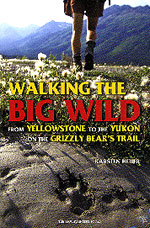 When I first received this book, I set it aside, thinking that it was another run-of-the-mill, long hike story. How wrong I was. It took only one chapter of Walking the Big Wild to get me hooked. In easy going, yet illuminating style of writing, Heur tells the story of his 2,000 mile hike.
When I first received this book, I set it aside, thinking that it was another run-of-the-mill, long hike story. How wrong I was. It took only one chapter of Walking the Big Wild to get me hooked. In easy going, yet illuminating style of writing, Heur tells the story of his 2,000 mile hike.
Let me restate: he hiked 2,000 miles from the northern Wyoming border, through Montana, and through British Columbia to Yukon. These are not the well traveled paths of the Appalachian or Pacific Crest trails. In many places, there are no trails. In the end, he reaches his destination, but not without a little help from his friends and his loyal companion, a border collie named Webster.
Amazon.com: More Information or Purchase
Letters from the Woods: Looking at Life through the Window of Wilderness. By Michael C. Hurley. Ragbagger Publishing, Raleigh, NC. ISBN 0976127504
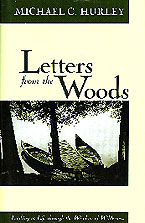
This is a collection of Michael Hurley's essays that appeared in Paddle & Portage, a quarterly journal of canoeing. I'm embarrassed to admit that as a long-time canoeist, I had never heard of the journal. Now after reading a sample of Hurley's work, I'm really sorry that I hadn't.
Paddle & Portage is no longer with us, but Letters from the Woods preserves the best of what might be called, for lack of a better descriptor, Hurley's homilies. I found them a refreshing change from the brusque and edgy writing so common these days. He reminisces about boyhood, family outings, and summer voyages, and always turns up a little gem of an insight that gives meaning to the simple pleasures of life in the woods.
Amazon.com: More Information or Purchase
Chasing Dreamtime: A Sea-going Hitchhiker's Journey through Memory and Myth. By Neva Sullawy. Brookview Press, Castleton-on-the-Hudson, NY. ISBN 0970764928.
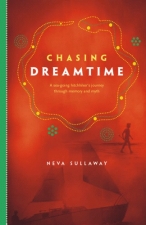
In 1975 Neva Sullaway takes off to sail around the world, and Chasing Dreamtime is about the adventure that ensues. On one leg of the journey, she is held at knifepoint. On another, she is arrested. As the title of the book promises, Sullaway fashions something of dream world out of her experiences, effectively drawing the reader in, not letting go until the book's ending. The book is not exclusively about outdoor adventure, but it is certainly is adventure: like a later day Odysseus, she is blown off course, and the journey becomes long and eventful.
Amazon.com: More Information or Purchase
The Laugh of the Water Nymph and Other River Storiesby Doug Ammons. Published by Water Nymph Press, Missoula, MT. ISBN 0-9761580-052950. (239 pages. Color photos.)
 One of the first books to catch my attention this year was Doug Ammons' long awaited collection of writings. Doug is a Missoula, Montana expeditionary kayaker. In the 1980's and 90's, he was on kayaking's cutting edge, tallying up an impressive list of descents and appearing in several films. Given that background, one would expect a fast paced, heart-thumping read, and, indeed, The Laugh of the Water Nymph is that. But there's a deeper and intellectual side to the book that helps it rise above standard river fare.
One of the first books to catch my attention this year was Doug Ammons' long awaited collection of writings. Doug is a Missoula, Montana expeditionary kayaker. In the 1980's and 90's, he was on kayaking's cutting edge, tallying up an impressive list of descents and appearing in several films. Given that background, one would expect a fast paced, heart-thumping read, and, indeed, The Laugh of the Water Nymph is that. But there's a deeper and intellectual side to the book that helps it rise above standard river fare.
At times, the book takes on a reflective quality. Take, for example, Ammons' discussion of horizon lines early in book. A horizon line, as a bit of an explanation, is a river runner's term. A kayaker sitting a few feet above the surface of the river has a very limited perspective. When approaching a rapid from the quiet water above, the river will seem to disappear, as if dropping off cliff. You see a horizon line in front of you and then nothing. That nothingness afterwards can be distinctly unnerving.
Since that first day on the Lochsa, I've paddled a lot of rivers. Kayaking has shown me a lot of fun, a lot of seriousness, and a simple fact: life is full of horizonlines. They come in all shapes and sizes - accidents and jobs, people, marriage, and children. Time is the current that pushes us toward the edges of what we know, usually faster than we can cope. And flowing water is the current of time made real. I know that fear comes from doubt about where those horizonlines lead. I also know that the truths of life, large and small, are what lie beyond each one.
Ammons takes us over quite a number of horizon lines on his kayaking odyssey. We venture to the rivers of Canada and Alaska, Mexico, South America and the Himalayas. Throughout it all, he writes with sensitivity, humor and candor.
In addition to well-crafted text, the book is beautifully produced. It includes an extravagant 36-page midsection with full-page color photos and two large-format pull outs. Most color work in the publishing is now done in China and points far-east, but in a refreshing departure from that trend, Ammons who self-published the book had it done in northern Idaho.
It's very reasonably priced at $29.95, and is available from the author at: https://www.dougammons.com/.
[End of Listing]


